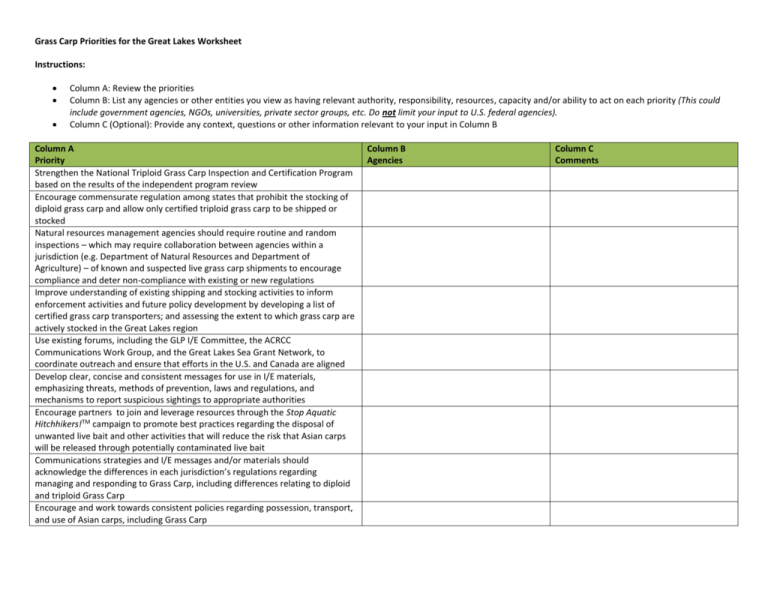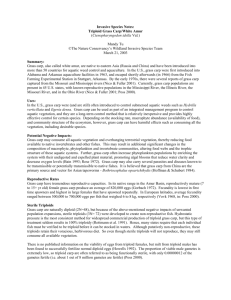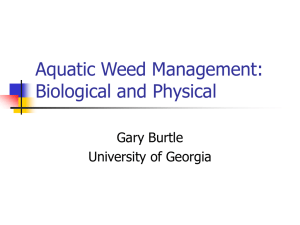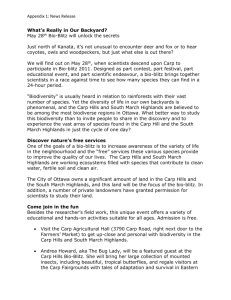Grass Carp Priorities for the Great Lakes Worksheet Instructions
advertisement

Grass Carp Priorities for the Great Lakes Worksheet Instructions: Column A: Review the priorities Column B: List any agencies or other entities you view as having relevant authority, responsibility, resources, capacity and/or ability to act on each priority (This could include government agencies, NGOs, universities, private sector groups, etc. Do not limit your input to U.S. federal agencies). Column C (Optional): Provide any context, questions or other information relevant to your input in Column B Column A Priority Strengthen the National Triploid Grass Carp Inspection and Certification Program based on the results of the independent program review Encourage commensurate regulation among states that prohibit the stocking of diploid grass carp and allow only certified triploid grass carp to be shipped or stocked Natural resources management agencies should require routine and random inspections – which may require collaboration between agencies within a jurisdiction (e.g. Department of Natural Resources and Department of Agriculture) – of known and suspected live grass carp shipments to encourage compliance and deter non-compliance with existing or new regulations Improve understanding of existing shipping and stocking activities to inform enforcement activities and future policy development by developing a list of certified grass carp transporters; and assessing the extent to which grass carp are actively stocked in the Great Lakes region Use existing forums, including the GLP I/E Committee, the ACRCC Communications Work Group, and the Great Lakes Sea Grant Network, to coordinate outreach and ensure that efforts in the U.S. and Canada are aligned Develop clear, concise and consistent messages for use in I/E materials, emphasizing threats, methods of prevention, laws and regulations, and mechanisms to report suspicious sightings to appropriate authorities Encourage partners to join and leverage resources through the Stop Aquatic Hitchhikers!TM campaign to promote best practices regarding the disposal of unwanted live bait and other activities that will reduce the risk that Asian carps will be released through potentially contaminated live bait Communications strategies and I/E messages and/or materials should acknowledge the differences in each jurisdiction’s regulations regarding managing and responding to Grass Carp, including differences relating to diploid and triploid Grass Carp Encourage and work towards consistent policies regarding possession, transport, and use of Asian carps, including Grass Carp Column B Agencies Column C Comments Column A Priority Quantify past stocking introductions to assess the scale and extent of the potential threat: Collate data on historic introductions of triploid and diploid Grass Carp into the Great Lakes basin (i.e., sites, numbers, ploidy status) to quantify potential scale of introductions and identify locations with the greatest historic introduction pressure Determine the extent, origin and nature of any natural Grass Carp recruitment within the Great Lakes basin through: Targeted surveillance and outreach/education to maximize collections of any Grass Carp captured through targeted surveys or as incidental bycatch. Record location of capture and determine ploidy status (e.g., diploid versus triploid) of captured Grass Carp. Undertake analysis of otolith microchemistry of captured fish to determine fish origin, where recruitment is occurring (for diploid fish), extent of recruitment and movement within the Great Lakes basin. Record additional life history and reproductive information (per standardized protocols in Appendix B) from all captured Grass Carp to improve understanding of Great Lakes recruitment dynamics Undertake movement studies to identify preferred habitats, home range and seasonal movement patterns to inform management strategies Determine whether diploid Grass Carp are still being imported into the basin: Undertake surveillance and monitoring of key pathways of legal and illegal importation of Grass Carp to quantify the level of diploid contamination and movement of diploid stocks into the basin. Quantify the levels of diploid contamination of Grass Carp stocks by monitoring importations of certified triploid Grass Carp to assess effectiveness of USFWS National Triploid Grass Carp Inspection and Certification Program Grass Carp data collection should be coordinated and communicated to help federal, state and provincial management and research entities better understand the scale of the problem, to facilitate a regional analysis and ensure information collected from any Grass Carp captures is maximized. Develop a guidance document for data sharing and external communication. Explore housing this collection information within appropriate regional or national entities that facilitates open access to all the data Broaden the collection of Grass Carp through other means such as commercial fishers, power plants and other industrial facilities to enhance datasets Column B Agencies Column C Comments Column A Priority Adopt standardized protocols for collection and analyses of specimens to ensure data standards, quality assurance and that all relevant information is collected from all Grass Carp captured in the basin, including but not limited to information on ploidy, otolith micro-chemistry, reproductive and life history characteristics Identify which laboratories are available and have capacity and equipment to undertake appropriate elemental analysis of Grass Carp otoliths Column B Agencies Column C Comments









